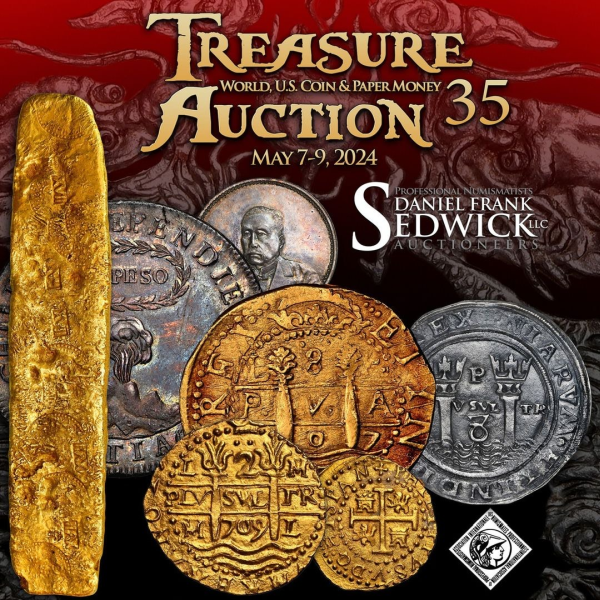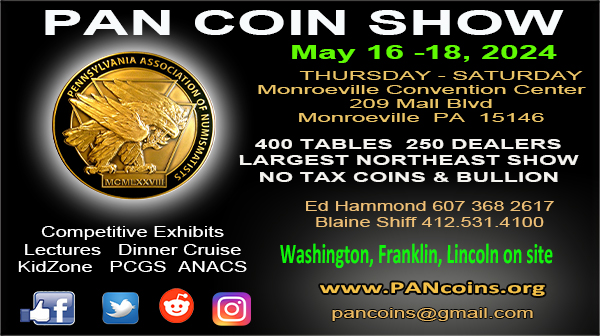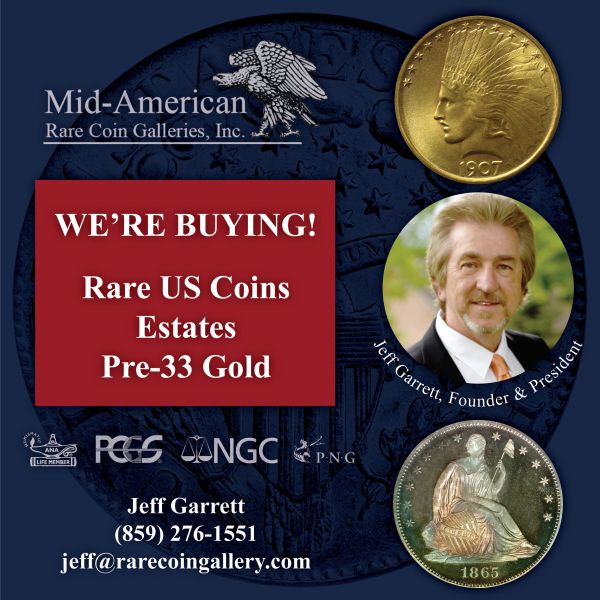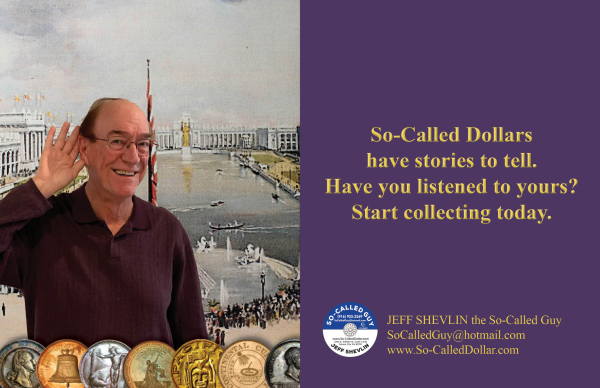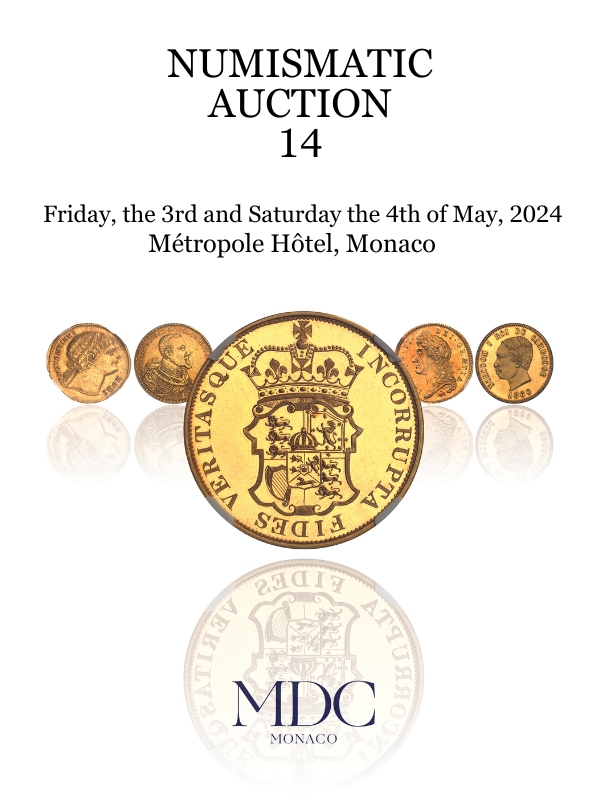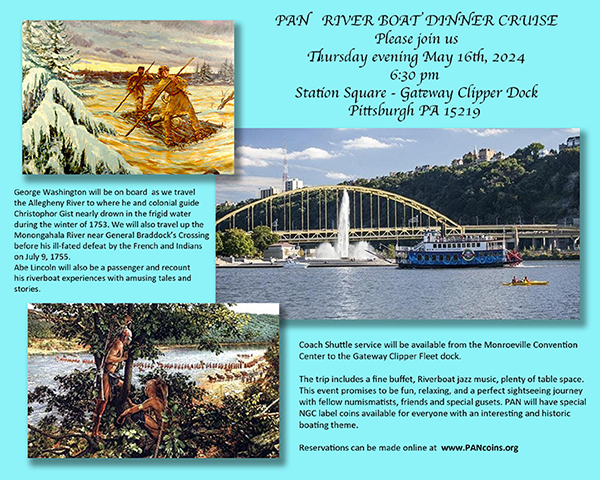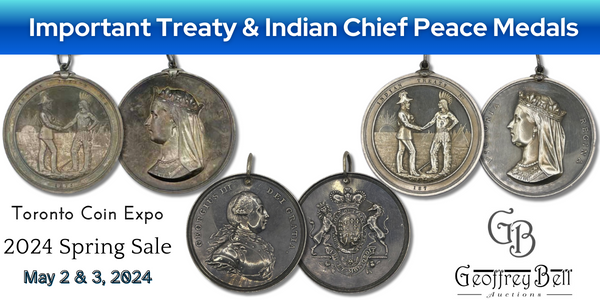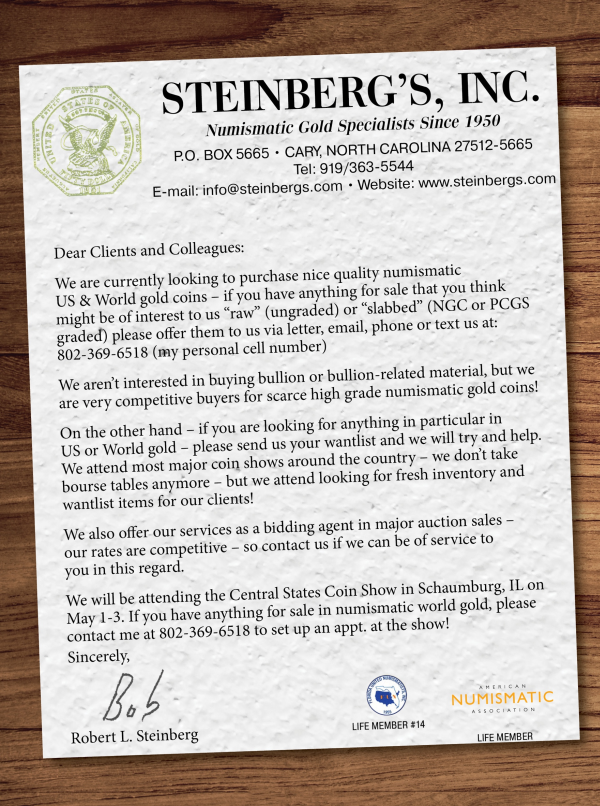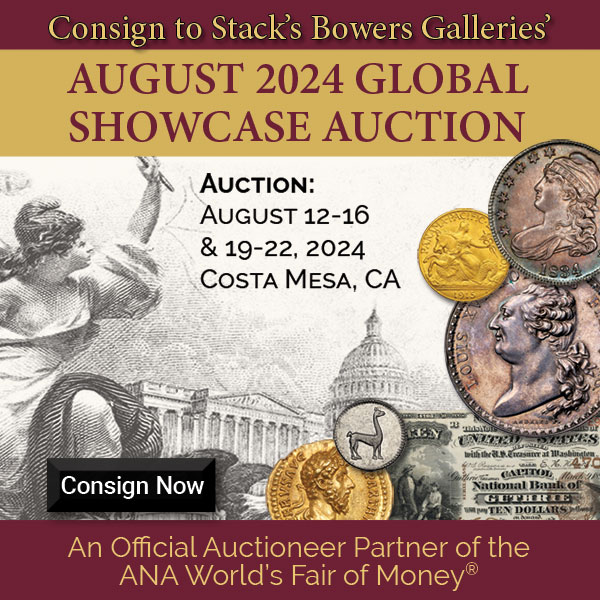
Visit our NBS Sponsors
About UsThe Numismatic Bibliomania Society is a non-profit association devoted to the study and enjoyment of numismatic literature. For more information please see our web site at coinbooks.org SubscriptionsThose wishing to become new E-Sylum subscribers (or wishing to Unsubscribe) can go to the following web page link MembershipThere is a membership application available on the web site Membership Application To join, print the application and return it with your check to the address printed on the application. Print/Digital membership is $40 to addresses in the U.S., and $60 elsewhere. A digital-only membership is available for $25. For those without web access, write to: Jeff Dickerson, Treasurer AsylumFor Asylum mailing address changes and other membership questions, contact Jeff at this email address: treasurer@coinbooks.org SubmissionsTo submit items for publication in The E-Sylum, write to the Editor at this address: whomren@gmail.com BUY THE BOOK BEFORE THE COIN |
- WAYNE'S WORDS: THE E-SYLUM APRIL 28, 2024
- CHRISTOPHER CHALLIS NUMISMATIC LIBRARY
- NEW BOOK: GOLD COINAGE OF THE LOW COUNTRIES
- NEW BOOK: COLONIALISM'S CURRENCY
- BANKNOTE BOOK GREECE CHAPTER PUBLISHED
- PERIODICAL: NUMISMATIQUE ASIATIQUE NO. 49
- BOOK REVIEW: 100 GREATEST ANCIENT COINS, 3RD ED.
- VIDEO: WHY BOGGS? WHY NOW?
- VIDEO: HISTORY OF DIE MAKING IN THE U.S.
- NOTES FROM E-SYLUM READERS: APRIL 28, 2024
- 2025 AMERICAN LIBERTY DESIGNS
- VOCABULARY TERM: PLANCHET
- NUMISMATIC EXHIBITIONS AT U.S. BANKS
- THE INFAMOUS GROUX COLLECTION
- ATLAS NUMISMATICS SELECTIONS: APRIL 28, 2024
- SEDWICK OFFERS FIVE POUND ATOCHA GOLD BAR
- NOONAN'S OFFERS OLYMPIC MEDALS
- BANKNOTES OF THE DEUTSCH-ASIATISCHE BANK
- NUMISMATIC NUGGETS: APRIL 28, 2024
- SWEDISH ISLAND SILVER BRACTEATE HOARD
- EURO COIN COUNTERFEITERS CAUGHT
- EURO BOOK COUNTERFEITERS CAUGHT
- BOY REBUILDS SHREDDED 10,000 YEN BILL
- LOOSE CHANGE: APRIL 28, 2024
- FEATURED WEBSITE: ROCHESTER NUMISMATIC ASSOCIATION
Content presented in The E-Sylum is not necessarily researched or independently fact-checked, and views expressed do not necessarily represent those of the Numismatic Bibliomania Society.
WAYNE'S WORDS: THE E-SYLUM APRIL 28, 2024
 New subscribers this week include:
Pamela Herrick,
Curator of Gilroy Roberts Collection at Community College of Philadelphia;
Welcome aboard! We now have 7,271 subscribers.
New subscribers this week include:
Pamela Herrick,
Curator of Gilroy Roberts Collection at Community College of Philadelphia;
Welcome aboard! We now have 7,271 subscribers.
Thank you for reading The E-Sylum. If you enjoy it, please send me the email addresses of friends you think may enjoy it as well and I'll send them a subscription. Contact me at whomren@gmail.com anytime regarding your subscription, or questions, comments or suggestions about our content.
This week we open with a numismatic literature fixed price list, three new books, a periodical issue, a book review, updates from the Newman Numismatic Portal, and more.
Other topics this week include gold coinage of the Low Countries, money artist J.S.G. Boggs, die making in the U.S., planchets, numismatic exhibitions at banks, the Groux collection, fixed price and auction offerings, Olympic medals, coin and book counterfeiters, and the Rochester Numismatic Association.
To learn more about Dr. Christopher Challis, the formation of Canadian money, the 100 greatest ancient coins, Greek banknotes, Spanish money in the Eastern European colonies, a 50-year button search, 2025 silver American Liberty designs, the protesting nymph, a 400-year-old gold bar, the Art Directors Club medal, J.N.T. Levick, the old receipt weirdo and Verminus, the god of cattle worms, read on. Have a great week, everyone!
Wayne Homren
Editor, The E-Sylum
CHRISTOPHER CHALLIS NUMISMATIC LIBRARY
Mitch Fraas passed along notice of a numismatic literature price list from York, UK bookseller Ken Spelman. Thanks. Here are a few selections. -Editor
Ken Spelman - Short List 31
Here is the next in an occasional series of short-lists. Coinage History - Books from the Library of Dr Christopher Challis.
Dr C. Challis (1939-2021), was a leading specialist in Tudor coinage and mint operations, and wrote The Tudor Coinage – 1978, A New History of the Royal Mint (Ed.) - 1992, and published many papers. He edited the British Numismatic Journal for many years.
NEW BOOK: GOLD COINAGE OF THE LOW COUNTRIES
Hugo Vanhoudt and John Sanders have published a new book on the gold coinage of Belgium, Luxembourg and The Netherlands. -Editor
(from 3th Cent. BC to present)
by Hugo Vanhoudt / John Saunders
LUXEMBOURG
THE NETHERLANDS
 This book gives a complete overview of all the gold coins and special
issues in gold produced on the territory of present-day Belgium,
Luxembourg and The Netherlands and Overseas territories, from the
Celts to 2022.
This book gives a complete overview of all the gold coins and special
issues in gold produced on the territory of present-day Belgium,
Luxembourg and The Netherlands and Overseas territories, from the
Celts to 2022.
A description on 2000 illustrated gold coin types, including special issues as patterns and off-metal strikes, with details of their obverse, reverse, edge, weight, fineness and rarity, and prices per date for different grades.
440 pages (29,7 x 21.0 cm),
fully illustrated in color, hardboard cover.
ISBN 978-1-7356598-1-7
NEW BOOK: COLONIALISM'S CURRENCY
Well, not new actually, but new to us - we haven't covered this 2020 book yet in The E-Sylum. I learned about it through a review by Jesse Kraft in the 2024 issue 1 of ANS Magazine from the American Numismatic Society. -Editor
Colonialism's Currency
Money, State, and First Nations in Canada, 1820-1950
By Brian Gettler
Money, often portrayed as a straightforward representation of market value, is also a political force, a technology for remaking space and population. This was especially true in nineteenth- and twentieth-century Canada, where money - in many forms - provided an effective means of disseminating colonial social values, laying claim to national space, and disciplining colonized peoples.
BANKNOTE BOOK GREECE CHAPTER PUBLISHED
A new chapter of The Banknote Book has been published by Whitman-CDN. Written by Tristan Williams and Owen Linzmayer, the 146-page catalog covers 1,273 varieties of Greek notes issued from 1822 – 1998. -Editor
PERIODICAL: NUMISMATIQUE ASIATIQUE NO. 49
Here are the contents of the latest 86-page issue of Numismatique Asiatique. -Editor
Numismatique ibérique
Iberian numismatics
SPECIAL NUMBER
SPANISH COINS IN THE EAST INDIES
La circulation de l'argent espagnol dans les colonies européennes d'Orient
The circulation of Spanish money in the Eastern European colonies
by Pedro Damián Cano Borrego
Contremarques chinoises sur monnaies espagnoles
Chinese countermarks on Spanish coins
by José Antonio de la Fuente
BOOK REVIEW: 100 GREATEST ANCIENT COINS, 3RD ED.
Mike Markowitz wrote a review of the new edition of Whitman's 100 Greatest Ancient Coins for CoinWeek. Here's an excerpt - see the complete article online. -Editor
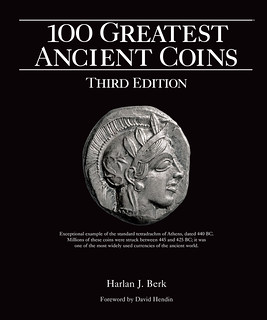 Whitman Publishing produces a series of “100 Greatest” coin books, including classic U.S., modern U.S., modern World, U.S. Errors, Canadian coins and tokens, and Women on Coins. Harlan Berk was the perfect author to tackle the challenge of selecting and documenting the 100 Greatest Ancient Coins. In 2008, Berk published the 131-page first edition of this richly illustrated large-format book. A revised second edition of 138 pages appeared in 2019. The first two editions sold out. This new third edition runs to 152 pages with much new content.
Whitman Publishing produces a series of “100 Greatest” coin books, including classic U.S., modern U.S., modern World, U.S. Errors, Canadian coins and tokens, and Women on Coins. Harlan Berk was the perfect author to tackle the challenge of selecting and documenting the 100 Greatest Ancient Coins. In 2008, Berk published the 131-page first edition of this richly illustrated large-format book. A revised second edition of 138 pages appeared in 2019. The first two editions sold out. This new third edition runs to 152 pages with much new content.
The choice of the “100 greatest ancient coins” and their ranking was based on a survey of museum curators, classical scholars, dealers, and collectors. There was a high degree of consensus among the experts. Rather more than 100 individual coins are pictured and described, because some of the categories, such as “Coinage of Croesus” (#9) and “Athens tetradrachm” (#38) include multiple types. Thirty-eight of the coins are Roman; six are Byzantine; and the rest could be loosely categorized as “Greek”, including Phoenician, Carthaginian, and Judean issues.
THE BOOK BAZARRE
VIDEO: WHY BOGGS? WHY NOW?
The latest addition to the Newman Numismatic Portal is a video of my recent talk on money artist J.S.G. Boggs. Project Coordinator Len Augsburger provided the following report. -Editor
Wayne Homren Speaks on J. S. G. Boggs
Our E-Sylum editor Wayne Homren presented on April 3 at Washington University in St. Louis on the performance artist J. S. G. Boggs (1955-2017). Boggs was well known for exchanging obvious imitations of paper money for goods and services. His work was equally pursued by collectors and law enforcement, which remained perpetually vexed in its effort to convict an artist who never represented his work as legal tender. Wayne’s talk was held in conjunction with the current numismatic exhibit at Washington University, Coins Across Time: Ancient to American Numismatics. This exhibit, in the Newman Tower portion of Olin Library, runs through July 7.
VIDEO: HISTORY OF DIE MAKING IN THE U.S.
The David Lisot Video Library on the Newman Numismatic Portal can be found at:
https://nnp.wustl.edu/library/multimediadetail/522852
We highlight one of his videos each week in The E-Sylum. Here's one from 2005 about die making in the United States. -Editor
NOTES FROM E-SYLUM READERS: APRIL 28, 2024
On Eponymous Numismatic Classifications
Len Augsburger of the Newman Numismatic Portal writes:
"Below is an excerpt from the forthcoming bibliography of Eric P. Newman’s publications, the draft of which is up to 138 pages."
Newman 36. Foreword to America’s Foreign Coins: An Illustrated Standard Catalogue with Valuation of Foreign Coins with Legal Tender Status in the United States, 1793-1857, by Oscar D. Schilke and Raphael E. Solomon, IX-X. New York: The Coin and Currency Institute, Inc., 1964.
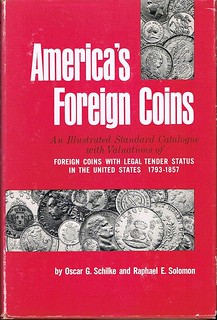 Newman opens by remarking on how inconceivable it is that it took the United States Mint 67 years — from 1793 until 1857 — to replace foreign coinage in circulation with United States coinage. He underscores that, prior to the American Revolution, what little gold and silver that circulated in the American colonies consisted of foreign, not British, coinage. The adoption of the Spanish silver dollar as the U.S. coinage unit after the Revolution was hoped to be a temporary expedient, with the switch over to a decimal system of American coinage hoped to be accomplished soon, but unforeseen problems and unexpected developments kept foreign coinage in circulation for three generations. Newman closes by reminding the reader that this book does not cover the minor coinage that never attained legal tender status: everything ranging from English halfpence (genuine and counterfeit) to American state coinages to Nova Constellatio coppers and Fugio cents.
Newman opens by remarking on how inconceivable it is that it took the United States Mint 67 years — from 1793 until 1857 — to replace foreign coinage in circulation with United States coinage. He underscores that, prior to the American Revolution, what little gold and silver that circulated in the American colonies consisted of foreign, not British, coinage. The adoption of the Spanish silver dollar as the U.S. coinage unit after the Revolution was hoped to be a temporary expedient, with the switch over to a decimal system of American coinage hoped to be accomplished soon, but unforeseen problems and unexpected developments kept foreign coinage in circulation for three generations. Newman closes by reminding the reader that this book does not cover the minor coinage that never attained legal tender status: everything ranging from English halfpence (genuine and counterfeit) to American state coinages to Nova Constellatio coppers and Fugio cents.
Newman accepted Schilke and Solomon’s offer to write a preface in correspondence dated May 10, 1962. In a follow up letter on May 23, Newman weighed in on eponymous numismatic classifications: “I believe it is immodest for you to refer to ‘S. S.’ numbers in your own book. That is for others do to.” Newman practiced what he preached. He did not introduce “Newman” nomenclature in his work on Fugios (1949), Continental dollars (1952) American Plantations tokens (1955), or Virginia coppers (1956). However, numismatists today commonly use the “Newman” term when referring to die varieties within these series. Schilke and Solomon took Newman’s advice, and the final version included only numbered (and not named) varieties.
To read the earlier E-Sylum article, see:
OSCAR GOTTLIEB SCHILKE (1903-1965)
(https://www.coinbooks.org/v27/esylum_v27n16a13.html)
Other topics this week include the Grading Scale, buttons, the Nashua Coin Club, and a Silver Dollar 25th Wedding Anniversary Plaque. -Editor
2025 AMERICAN LIBERTY DESIGNS
"Have you seen this Statue of Liberty design that the CCAC is recommending for American silver Liberty for 2025? I wasn't able to get the whole coin in the scan but it looks to me like you'd see it on the side of a train car."
I hadn't seen any of these designs yet. The meeting minutes haven't been posted to the CCAC website yet, but here's what Coin World reported. -Editor
The CCAC’s recommended obverse design for the silver American Liberty medal reimagines the Statue of Liberty in stylized graffiti form. The base of Liberty’s torch is in the shape of a crown that rests on the L in LIBERTY. The crown is at once a tribute to the graffiti art form (the crown is a reference to graffiti artists as “kings” of the art form) and an allusion to how Americans converted their rule under a monarchy into their vision of a new nation.
VOCABULARY TERM: PLANCHET
Here's another entry from Dick Johnson's Encyclopedia of Coin and Medal Terminology. -Editor
Planchet. A round metal disk (or other shape) made for striking into a coin or medal. The term blank is widely used in the metalworking field. Planchet is only used for coins and medals. Likewise, the word flan is French for a coin or medal blank. A planchet is the end product of the rolling and BLANKING operation. It produces a piece of metal of the proper composition, weight, thickness (and diameter if round). Further to make a blank into a planchet requires treatment of the edge[RWB1].
NUMISMATIC EXHIBITIONS AT U.S. BANKS
E-Sylum Feature Writer and American Numismatic Biographies author Pete Smith submitted this article on Numismatic Exhibitions at U.S. Banks. Thanks! -Editor
I realized this week that I had written several articles about coin exhibitions at banks. I also realized how common these have been. This week I will offer a review and some additional comments.
Coin clubs have often presented coin exhibits for banks during National Coin Week. I offer someone else the opportunity to catalog those. I would not be surprised it there have been more than a thousand.
THE INFAMOUS GROUX COLLECTION
Bob Van Ryzin published a nice article for Numismatic News on numismatic oddball Daniel Edward Groux and his grandiose plans for disposing of his "famous" collection. Here's an excerpt - see the complete article online. -Editor
 Groux came to America in the 1840s and established himself as a self-proclaimed language teacher and a professor of numismatics. An advertisement that regularly appeared in the Washington (D.C.) Sentinel reads: “Modern Languages – D.E. Groux, a native of France, teacher of modern languages, especially French, Spanish, and German. Translations made with correctness and punctuality. Professor of Numesmatics [sic], for the classification and explanation of medals and coins.”
Groux came to America in the 1840s and established himself as a self-proclaimed language teacher and a professor of numismatics. An advertisement that regularly appeared in the Washington (D.C.) Sentinel reads: “Modern Languages – D.E. Groux, a native of France, teacher of modern languages, especially French, Spanish, and German. Translations made with correctness and punctuality. Professor of Numesmatics [sic], for the classification and explanation of medals and coins.”
Groux’s personal collection of ancient through modern coins and medals was heralded as one of the finest, particularly by its owner, whose overly generous valuations thereof were readily accepted in the general press.
ATLAS NUMISMATICS SELECTIONS: APRIL 28, 2024
Atlas Numismatics has updated their website with 234 new coins, medals, and tokens at fixed prices. Selections include the following items. -Editor
1078301 | GREEK. THRACE. Island of Thasos. Struck circa 435-400 BC. AR Stater. NGC AU? (About Uncirculated ?) Strike 5/5 Surface 3/5 Fine Style. 8.80gm. Satyr advancing right, carrying off protesting nymph / Quadripartite incuse square. Le Rider, Thasiennes 6; HGC 6, 334.
Given the star designation by NGC for exceptional eye appeal.
Ex Millennia Collection - Goldberg Auction 46 (31 May 2006) Lot 26.
$6,950
SEDWICK OFFERS FIVE POUND ATOCHA GOLD BAR
Here's the press release for the upcoming Daniel Frank Sedwick, LLC auction sale. Amazing material. -Editor
When the Spanish treasure galleon Nuestra Señora de Atocha sank in 1622 off what is now Key West, Florida, she took down untold treasures in gold and silver. And now a particularly famous piece of treasure from the wreck is crossing the auction block.
One of the largest gold bars ever recovered from a Spanish colonial shipwreck is up for sale on May 7th in an auction conducted by Daniel Frank Sedwick, LLC in Winter Park, Florida.
NOONAN'S OFFERS OLYMPIC MEDALS
Olympic medals and related ephemera are being offered in May by Noonans Mayfair. Here's the press release. -Editor
The medals and ephemera awarded to Guy Butler, winner of four Olympic medals including a Gold at the 1920 Games are to be sold at Noonans Mayfair in their auction of Historical Medals on Thursday, May 9, 2024. Bell was Britain’s most bemedalled Olympic athlete of all time, a distinction shared since 1984 with Sebastian Coe, Christine Ohuruogu and Mo Farah. Ranging from International including those from the 1920, 1924 and 1928 Olympic Games and regional medals to trophies to blazers, the collection is being sold by his four grandchildren and is expected to fetch £15,000-20,000.
As Peter Preston-Morley commented: “We are very pleased to be selling this collection – just two months before the 2024 Olympic Games will be held in Paris. Guy Butler was a truly outstanding athlete who not only won more Olympic medals that any other British Athlete until 1984 when he was caught up by Sebastian Coe! This wasn’t his only feat, he even outran the legendary Harold Abrahams and came third to Eric Liddell, other heroes of the 1924 Olympics, whose feats were celebrated in the 1981 blockbuster film Chariots of Fire.”
BANKNOTES OF THE DEUTSCH-ASIATISCHE BANK
Stack's Bowers Director of Consignments and Senior Numismatist Dennis Hengeveld published an article about the banknotes of the Deutsch-Asiatische Bank. -Editor
Like other European nations, Germany tried to expand its presence in the Far East in the second half of the 19th century. In China, Germany took part in the Shanghai International Settlement, an enclave in Shanghai from which European governments were allowed to trade. It was here that in 1889 the Deutsch-Asiatische Bank was founded. It had been in the making for the previous decade, but its establishment had been delayed several times. According to Maximilian Müller-Jabusch in his 50-year history of the bank, the main reason for the initial setup of the bank was to finance railroad construction; when the bank got up and running it became more focused on trade financing. Regardless, it played an important role in the development of railroads in China through its banking. Even though Germany lost its colonies at the conclusion of World War I, the bank continued operating in a much-reduced capacity and was eventually merged with Deutsche Bank in the late 1980s.
NUMISMATIC NUGGETS: APRIL 28, 2024
Here's a selection of interesting or unusual items I came across in the marketplace this week. Tell us what you think of some of these. -Editor
The Parisii Quarter Stater
Northeast Gaul, The Parisii, Quarter Stater, c. 60-40 BC, BN 7796 R.Northeast Gaul, The Parisii, Quarter Stater, c. 60-40 BC, Traité de numismatique celtique (J-B. Colbert de Beaulieu), Classe V, fig. 21, BN 7796, LT 7796/7798, SLM 273, 1,54 g - highly detailed, immacuately centered and thus one of the best known examples of this extremely rare and important piece of Celtic art and Parisian history.
Already by the end of the 3rd cent BC, a settlement built on the Île de la Cité was inhabited by a Gallic tribe known as the Parisii. Julius Caesar wrote in "Commentarii de Bello Gallico" that the inhabitants would rather burn their town - which Caesar called Luteciam Parisiorum (Lutetia of the Parisii) - than surrender it to the Romans.
From the 30 April 2024 Bonham's sale. -Editor
To read the complete lot description, see:
Northeast Gaul, The Parisii, Quarter Stater, c. 60-40 BC, BN 7796
(https://www.bonhams.com/auction/30401/lot/204/northeast-gaul-the-parisii-quarter-stater-c-60-40-bc-bn-7796/)
Other topics this week include a St. Thomas Ice Token, an Art Directors Club Medal, and a Confederate Half Dollar Scott Restrike Medal. -Editor
SWEDISH ISLAND SILVER BRACTEATE HOARD
Paul Horner passed along this article about a find in Sweden of a hoard of 170 silver bracteates, which resemble coins. Thanks. -Editor
Swedish archaeologists recently uncovered a 12th century grave during an archaeological dig – and found buried treasure along with it.
The Jönköping County Museum announced the find in a Mar. 27 press release that was translated from Swedish to English. The discovery happened during an excavation of a grave in an old church in Visingsö, a Swedish island.
The coins were found in the grave of a man that experts believed was between 20 and 25 years old when he died. The pieces of metal were produced between 1150 and 1180.
EURO COIN COUNTERFEITERS CAUGHT
Howard Berlin passed along this story about the dismantling of a counterfeiting ring in Spain that circulated fake two euro coins. Thanks! That's great to hear. -Editor
 On Wednesday, German press agency dpa reported that Spain's National Police had busted a money counterfeiting ring that had allegedly been putting fake €2 coins into circulation all across Europe. With the help of the pan-EU police organization Europol, the Spanish authorities were reportedly able to uncover a counterfeit workshop in the central city of Toledo that they described as "the most important in Europe over the past 10 years."
On Wednesday, German press agency dpa reported that Spain's National Police had busted a money counterfeiting ring that had allegedly been putting fake €2 coins into circulation all across Europe. With the help of the pan-EU police organization Europol, the Spanish authorities were reportedly able to uncover a counterfeit workshop in the central city of Toledo that they described as "the most important in Europe over the past 10 years."
The ring reportedly brought nearly 500,000 coins "of high quality" onto the European market. Ten individuals, all Chinese nationals, were reportedly arrested. Spain's National Police said they had been investigating the case for six years, and described the investigations as "extremely difficult and drawn out, not least because of the secretive nature of the organization, and also the near impossibility of being able to follow a trail, which is characteristic for forged coins."
EURO BOOK COUNTERFEITERS CAUGHT
And the bibliophiles among us can rejoice in the capture of a gang of book counterfeiters. Thanks to Loren Gatch for passing this along. -Editor
 Works by Russian literary greats such as Alexander Pushkin and Nikolai Gogol were substituted with valueless counterfeits from European libraries.
Works by Russian literary greats such as Alexander Pushkin and Nikolai Gogol were substituted with valueless counterfeits from European libraries.
European authorities say they have rounded up a criminal gang who stole rare antique books worth €2.5 million from libraries across Europe.
In a press release, Europol announced they had arrested nine Georgian nationals in Georgia and Lithuania who are thought to have collaborated in the plot, in which at least 170 books were stolen.
BOY REBUILDS SHREDDED 10,000 YEN BILL
Destroyed banknotes make the news regularly. Here's a story from Japan about a boy's effort to reconstruct a shredded 10,000 yen bill. -Editor
A Japanese boy allegedly spent three weeks piecing back together a 10,000 yen bill like a jigsaw puzzle after it had been accidentally put through a paper shredder.
Japanese Twitter user ‘Tomo’ recently completed one of the hardest puzzles he’s ever done – putting back together a 10,000 yen ($65) bill that had been shredded into thousands of pieces. Apparently, his father accidentally shredded an old envelope at work after forgetting that he had put a 10,000 yen bill in it months ago. Realizing his mistake, the man decided to use his mistake as a challenging project for his son. He took home the entire shredder waste basket and told his son that if he could piece together the shredded bill and exchange it for a new one at the bank, he could keep it. It was a daunting project for even the most avid jigsaw puzzle enthusiast, but one the boy gladly accepted.
LOOSE CHANGE: APRIL 28, 2024
Here are some additional items in the media this week that may be of interest. -Editor
CoinWeek published a profile of New York City collector J.N.T. Levick. The article illustrates some of the great coins pedigreed to his collection. -Editor
His collection was sold in parcels starting in 1859. Levick built a major token collection focusing on the issues of America’s eastern states, which comprised about 4,000-5,000 pieces (probably second to Groh’s 5,000+-piece collection)—owned a nearly uncirculated example of the 1792 Birch cent (Judd-3) with a plain edge. This coin was sold at Cogan’s 1859 Sale ...
Civil War Veteran; served in New York Volunteers and commissioned a Captain. Proposed publication of a monthly journal – which became the American Journal of Numismatics. Inducted into the ANA Numismatic Hall of Fame in 2018.
To read the complete article, see:
Joseph Napoleon Tricot “J.N.T.” Levick : Coin Collector Profile
(https://coinweek.com/joseph-napoleon-tricot-j-n-t-levick-coin-collector-profile/)
Other topics this week include Roman household Gods on coins, and the demise of checks. -Editor
FEATURED WEBSITE: ROCHESTER NUMISMATIC ASSOCIATION
This week's Featured Website is the Rochester Numismatic Association.
Dr. George P. French is credited as the founder of the RNA. He graduated from Columbia Medical College in 1888 and interned at St. Mary's Hospital in Rochester, NY. After a successful private practice of 24 years Dr. French also found time to collect coins, stamps and curios. His numismatic specialty was large U.S. cents and his collection was one of the finest of its kind.
French became the first president of the fledgling RNA organization that boasted 32 charter members. One of the earliest steps that French took was to facilitate the club's membership in the American Numismatic Association, becoming Branch 2, and now ANA Life Club Member #8. The ANA was a mere 21 years old at the time, having been founded in 1891. "Branch" was the designation given to clubs that joined the national organization.
The objective of the association is to foster the pursuit of numismatics as a science, cultivate fraternal relations among collectors and students, acquire and disseminate numismatic knowledge, assist and encourage new collectors and to form and maintain a collection of numismatic items and literature for the education of the members.




